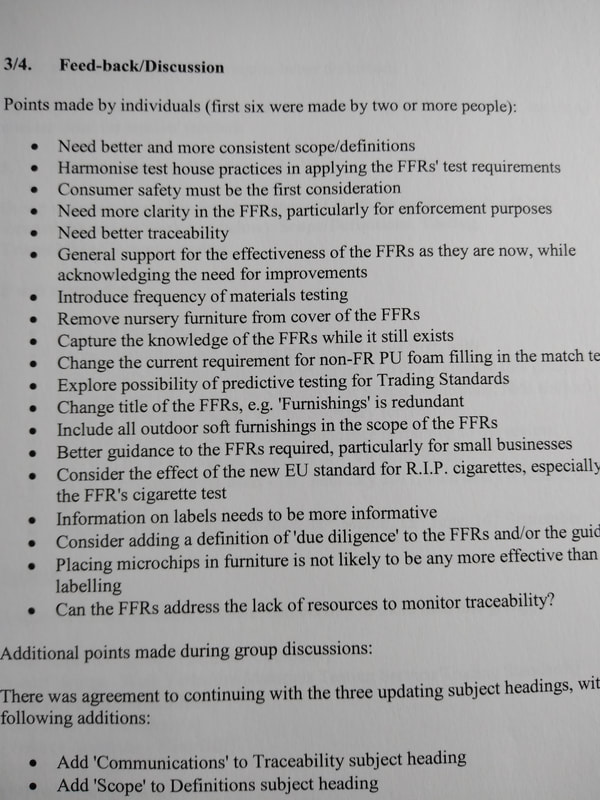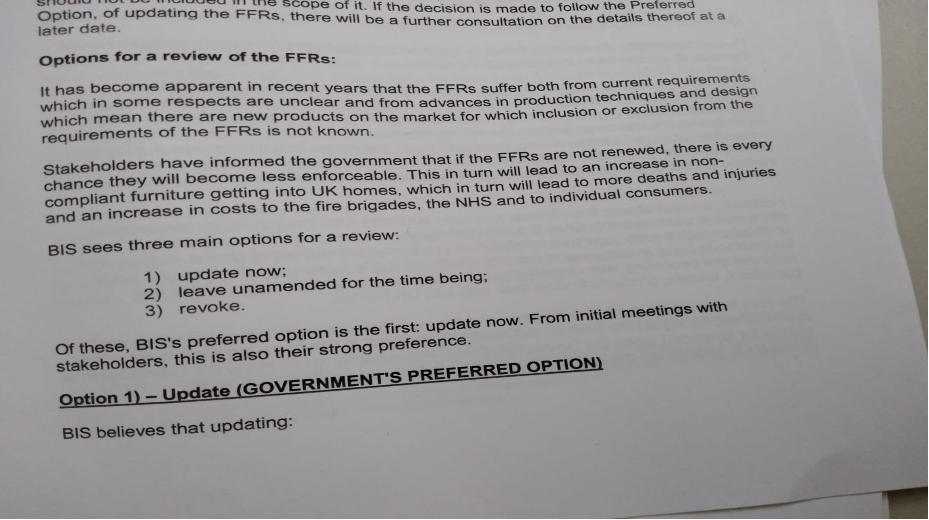It seems the OPSS is currently pressing FW/6 (working group at British Standards Institute) to base the new ignition standard for their new furniture regulations on the European standard EN 1021 Part 1 and 2. EN 1021 is for cigarette resistance (Part 1) and match/open flame resistance (Part 2) over a test rig to simulate an upholstered chair. It was originally based on the UK's cigarette and match tests (BS 5852 parts 1&2) with some differences, one of them significant.
Here's what's wrong with this plan (as every single member of FW/6 well knows):
1. EN 1021 Part 2 is not as stringent as the UK's open flame test, e.g. the test flame is placed against the fabric for 20 seconds in the UK test but only for 15 seconds in the EN test. Why the difference? Well, it seems that the huge fibre-producing German company Trevira worked hard on the EN committee responsible to get this 5 seconds reduction, having discovered that their fibres will resist igniting for that period of time, but not for 20. The OPSS has banged on for years now about how they will not replace the existing open flame standard with one that is less stringent. The fact they now plan to do so indicates that they have finally twigged that they painted themselves into a corner over this.
2. EN 1021 has some of the same key faults in common with BS 5852. For example, it does not cater for flammable materials close to the cover but not within the main body of say a sofa like the arms (the test rig is in effect two large furniture cushions, meaning that in practice cover material near the arms will ignite because items beneath and close to the cover do not have sufficient foam to protect against catching fire). And the fact that flame retardants wear off of fabrics easily means they will not comply with ignition tests soon after purchase in both test scenarios.
3. EN 1021 still leads to large volumes of flame retardants in furniture – e.g. some of the worst kinds, like the brominated varieties – in cover fabrics. The OPSS is supposed to be committed to reducing FRs in furniture.
4. The government itself proved in 2014/2015 that the open flame test in BS 5852 is not effective in practice; it does not prevent ignition. In 2014 it came up with a new open flame test that was effective and also would hugely reduce FRs in cover fabrics. Why therefore is the OPSS not using this to replace the existing test?
To summarise (if possible!): in 2014, the government proved that the UK match/open flame test is not effective and proposed a new test that was. From that point on, it delayed making changes, keeping in place a test that does not work and leads to millions of kgs of toxic flame retardants in UK furniture. In 2019, the Environmental Audit Committee recommended that the OPSS drop the open flame and fillings tests altogether. But instead, for the next five years the government created an impasse by setting up British Standards Institute to do the impossible: replace the existing open flame test (which does not work) with one that is just as stringent. BSI could not do so because no such standard exists or is possible to draft. Under pressure, the OPSS went out to consultation late last year on new regulations. It said these will be ready by October 2024 (they won't be). It intimated that the new standards to support the regulations would be ready about the same time. However, BSI told the government (but not the public of course) that it would be at least 2028 before new standards were ready. And that depended on the OPSS telling them what standards they wanted. Which they did not, and could not, do. Now, they are trying to rush through a EN standard equivalent even though:
- They could have done so ten years ago, if that was the answer, which it clearly isn't.
- The EN standard suffers many of the same faults at the current British standard, i.e. it is not effective in practice.
- The government knows that no EU country uses EN 1021 open flame test anyway, one reason being that they do not want large volumes of flame retardants in their furniture.
Not one person on FW/6 has made a stand over this, content for a mixture of reasons, most of them financial, to go along with this extended madness that results only in mass cancers and other illnesses in UK citizens, including babies and firefighters.


 RSS Feed
RSS Feed